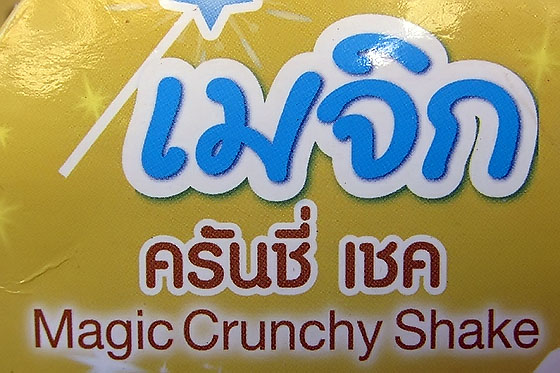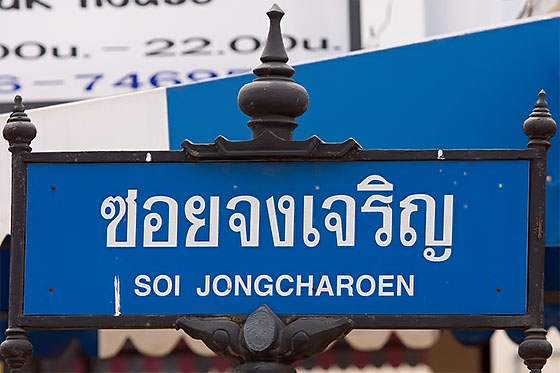Learn How To Read Thai - Tutorial 19
Review
If you've followed these tutorials so far you will be pleased to hear that we haven't got much further to go. I'm going to do one vowel and some more important consonants today but after that the only remaining consonants are fairly rare and I intend wrapping them up together in a single tutorial.
I've covered most of the important vowels. The long vowels can be tricky but the objective of these tutorials was to teach absolute beginners how to read things like signs, bus destinations, and menus. With those things you don't see many long vowels.
Another 'O' Vowel
โ
Writing practice: Download Worksheet
Writing practice: Download Worksheet
At first glance this might look a little like the sara ai vowels covered in Tutorial 8 except the hook at the top points the other way. Here they are so that you can make a comparison.
โ | ใ | ไ
A tip I was given by a Thai person is that when writing this character the top of the character is the same as the consonant ror reua.
โ | ร
It doesn't appear that often. Like the sara ai vowels it resembles, it is also written before the consonant. It can sound like sara or (Tutorial 11), that is, like an English 'o' as in 'song', or it can have a more 'oe' sound, as in 'toe'.
Writeen Thai is generally mor consistent phonetically than English, but there are a few anomalies.
Consonants With A 'ch' And 'j' Sound
I have stated that written Thai is quite consistent phonetically compared to English. As we have seen though, it isn't perfectly consistent and there is a little more inconsistency with the consonants below.
Thais get very defensive about any criticism of anything Thai - even if it isn't a real criticism. I was trying to discuss these inconsistencies with a couple of Thais and they got quite upset when I mentioned the inconsistency. They insisted there was no inconsistency even when they proved there was by pronouncing the words I asked them to speak.
ช
Name in Thai: ช ช้าง
Name in English: Chor Chaang (elephant)
Initial: ch
Final: t
Class: Low
Usage: Very common
Writing practice: Download Worksheet
Comments: This is the most common 'ch' consonant and comes up often. The way the consonant is written is quite similar to sor soh (Tutorial 10) except that sor soh has an additional notch. In the fancy fonts that Thais use on signs this can be a problem to spot so be careful. Here's a comparison of the two:
ช | ซ
As a final consonant it becomes a 't' sound but many bad transliteration systems show it as still making a 'ch' sound.
ฉ
Name in Thai: ฉ ฉิ่ง
Name in English: Chor Ching (cymbals)
Initial: ch
Final: t
Class: High
Usage: Fairly rare
Writing practice: Download Worksheet
Comments: Not seen that often. The basic sound is the same as chor chaang above except that this is a high class consonant, as opposed to chor chaang which is low class.
ฌ
Name in Thai: ฌ เฌอ
Name in English: Chor Cher (kind of tree)
Initial: ch
Final: -
Class: Low
Usage: Rare
Writing practice: Download Worksheet
Comments: This seldom seen consonant is another 'ch' sound when used as an initial consonant but it is never used as a final consonant. It is another Thai character that you needn't worry too much about remembering when you first start learning to read Thai. It is quite similar in shape to the nor nane consonant that makes an 'n' sound. Here are the two so that you can make a comparison.
ฌ | ณ
Many Thai characters are similar, but not quite the same. The more you read Thai, the easier it cecomes to distinguish them. The font used also makes a difference. With some fancy fonts I can't tell the difference.
จ
Name in Thai: จ จาน
Name in English: Jor Jaan (plate)
Initial: j
Final: t
Class: Mid
Usage: Very common
Writing practice: Download Worksheet
Comments: The eccentric author Mont Redmond says there is no 'j' sound in Thai. I disagree, but don't take my word for it. When you have an opportunity, ask a Thai person what the Thai word is for plate. Does it sound like 'jaan' or 'chaan'?
Don't believe anything that anyone else tells you, don't believe what you read in books, and don't believe what I write in these tutorials. You have ears and a brain. Use them to make your own decisions.
Bad transliteration systems (are there any good ones?) retain the 'j' sound when this consonant is used as a final consonant, thus telling you that the Thai word for police is tamruaj instead of dtum-roo-ut. If you say tamruaj to a Thai all you will get is a puzzled expression.
Reading Practice
As I have done with my previous tutorials, there now follows some words that use these new consonants along with previously taught consonants and vowels. If you have followed, understood and remembered everything you should be able to read these words very easily.
By now you should realise that I have extremely negative views about transliteration systems. They are bad even at the best of times, but with 'j' characters the problem is worse than usual for some reason.
The Thai 'jor jaan' character is usually transliterated into 'ch' rather than 'j'. Therefore, you will read about places such as Chulalongkorn University, but when you hear a Thai speak you will hear a 'j' and not a 'ch'. It is the same for the famous river in Bangkok, written as Chao Phraya.
With English words transliterated into Thai that start with 'j', Thais use the yor yuk 'y' consonant instead of jor jaan. I don't know why this is, but I have a theory that Germans provided a lot of input with transliteration systems and this would make sense in the German language.
You will hear Thais talking about wearing Levi 'yeans' instead of 'jeans' and when you can read enough Thai you will understand why. It's because the words is written starting with a Thai 'y' consonant.
There is also a very strange convention that a Thai 'j' sound is written as 'c' in English. Again, I don't know why. Google Translate uses this convention.
The Thai word for 'really' or 'truly' is pronounced 'jing'. An anomaly about the spelling of this word is that it contains an unpronounced ror reua consonant. The consonant is written, but ignored.
The Google Translate tool transliterates 'jor jaan' as 'c' and then also (wrongly) includes the 'ror reua' consonant that should be ignored. The result in Google Translate is that the word is pronounced 'cring', which makes me want to cringe (jing jing).
จาน
The initial consonant is the 'j' sound introduced today. Next is the long 'aa' vowel (Tutorial 7) and the final consonant is the 'n' sound (Tutorial 8).
The Thai word jaan is the word for plate and also the name of the 'j' character.
Tone: Mid-class initial consonant and live syllable = Mid tone (Tutorial 14)
จริง
The initial consonant is the 'j' sound introduced today. Next is the ror reua consonant, but although this consonant is written it is actually ignored. There are quite a few Thai words that have superfluous ror reua consonants.
After this are 'sara i' and 'ngor ngoo' which, when combined, make an 'ing' sound as in 'sing' or king'.
The Thai word jing is the word for 'really' or 'truly'. It is often repeated for emphasis - 'jing jing'. It is not 'cring' as per Google Translate, and it is not 'jaring' because the 'r' consonant is ignored.
Tone: Mid-class initial consonant and live syllable = Mid tone (Tutorial 14)
จำ
The initial consonant is the 'j' sound followed by 'sara um'. This is the Thai verb 'to remember' and it is pronounced 'jum' although transliteration systems will probably tell you 'cham' or 'jam' (like you have with bread).
Again, don't believe me, but ask a Thai person to say this word and listen to how it is pronounced.
Tone: Mid-class initial consonant and live syllable = Mid tone (Tutorial 14)
ช้าง
The initial consonant is one of the 'ch' sounds introduced today. Next is the long 'aa' vowel (Tutorial 7) and the final consonant is the 'ng' sound (Tutorial 4).
The Thai word chaang is the word for elephant and also the name of the 'ch' consonant used in this word. It is also a popular brand of Thai beer that is transliterated as Chang. Transliteration systems do not take into account any differences between long and short vowels. For the vowel used in this word I prefer to use 'aa' or 'ar' to indicate that it is a long vowel.
Tone: Low-class initial consonant and second tone mark = High tone (Tutorial 14)
ช่าง
The initial consonant is one of the 'ch' sounds introduced today. Next is the long 'aa' vowel (Tutorial 7) and the final consonant is the 'ng' sound (Tutorial 4).
The only difference between this word and the word for elephant is the tone mark. This word uses the first tone mark whereas the word for elephant uses the second tone mark.
It's the word used for a tradesman and it is used a lot. Once you start speaking Thai in Thailand you will hear and use this word often.
Tone: Low-class initial consonant and first tone mark = Falling tone (Tutorial 14)
ชั่วโมง
The first consonant is chor chaang. Above it you should have spotted mai-hun-aagaat and noticed that it is followed by wor wairn. If you remembered what I wrote in Tutorial 9 you will know that this combination makes an 'oo-uh' sound.
Tone first part: Low-class initial consonant and first tone mark = Falling tone (Tutorial 14)
The second part of the word begins with the vowel introduced today and is followed by the 'm' consonant (Tutorial 8) and then the 'ng' consonant (Tutorial 4).
This syllable is written Vowel-Consonant-Consonant but pronounced Consonant-Vowel-Consonant.
When you put all this together you get choo-uh mong which is the Thai word for hour.
Tone second part: Low-class initial consonant and live syllable = Mid tone (Tutorial 14)
I mentioned some inconsistencies and what I have found is that sometimes this letter makes more of a 'sh' sound than a 'ch' sound. When I hear Thais speak this word it sounds more like shoo-uh mong.
I'm not sure if this is actually the case or whether the sound has just been changed for everyday, colloquial speech.
I have already told you that 'r' sounds get dropped or changed to 'l' sounds in colloquial Thai, and it could be the case that colloquial Thai has also changed 'ch' to 'sh'.
Another example is the Thai phrase for 'cannot' which should be mai dai but in everyday speech is pronounced as may dai.
There are also lots of inconsistencies with transliteration when using these letters. If you look at the photo of the sign at the top of the page you will see that in the transliteration the jor jaan consonant has been transliterated to 'j' and to 'ch' in the same street name!

In the photo above the words 'Crunchy Shake' have been transliterated into Thai. Despite 'ch' and 'sh' having different sounds in English, the same Thai consonant has been used for both.
Even when chor chaang is used with Thai words, I notice that sometimes it sounds like 'ch' and sometimes it sounds like 'sh'.
The chor ching consonant doesn't appear that often but it is used for a very important word. This sign has the English translation but I've seen signs that are only in Thai. If you find yourself in an emergency situation in Thailand it's good to know this word.
uu-but-dti-het means accident and chuuk-chern means emergency. This is the entrance to a hospital accident and emergency department.

โรค
This word is written Vowel-Consonant-Consonant but pronounced Consonant-Vowel-Consonant.
The initial consonant is ror reua and the final consonant is kor kwaay. In this word, the 'sara o' vowel makes an 'o' sound as in 'roe' or 'blow' and not an 'o' sound as in 'rod' or 'pot'. It therefore sounds like 'roke' or 'roak' and it is the Thai word for disease.
Tone second part: Low-class initial consonant, long vowel and dead syllable = Falling tone (Tutorial 14)
โรง
This word is written Vowel-Consonant-Consonant but pronounced Consonant-Vowel-Consonant.
The initial consonant is ror reua and the final consonant is ngor ngoo. In this word, the 'sara o' vowel makes an 'o' sound as in 'rod' and not an 'o' sound as in 'roe' - the opposite to the example above. It therefore sounds like 'rong' and it is the Thai word for a building.
Lots of different types of buildings use 'rong' as a prefix. 'rong rien' = school, 'rong ngaan' = factory, 'rong payaabaan' = hospital, etc.
This example and the one above illustrate the two different sounds that this vowel makes.
Tone second part: Low-class initial consonant, live syllable = Mid tone (Tutorial 14)
Questions And Feedback
If you have any comments, questions or suggestions, feel free to contact me. Your feedback will help me to improve these pages.
Recommended Books
Amazon UK
Amazon UK
Amazon US
Amazon US

